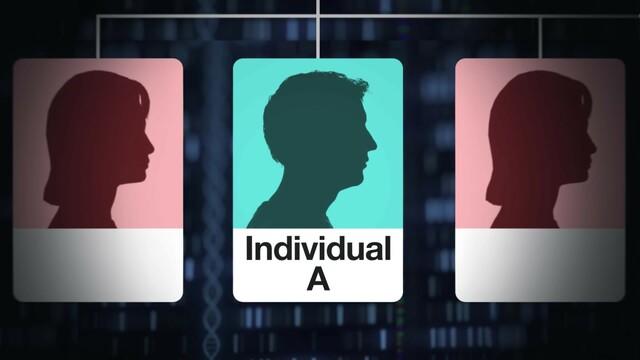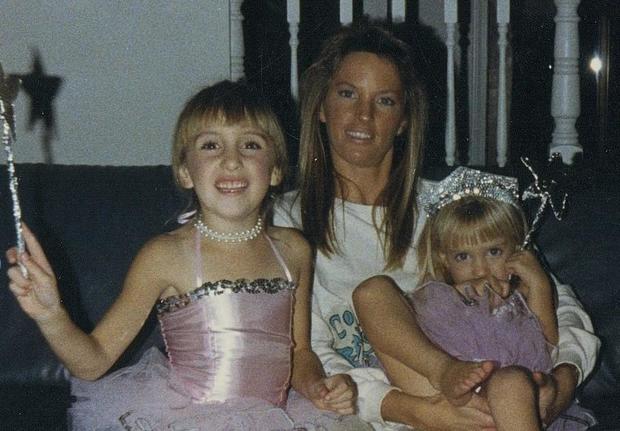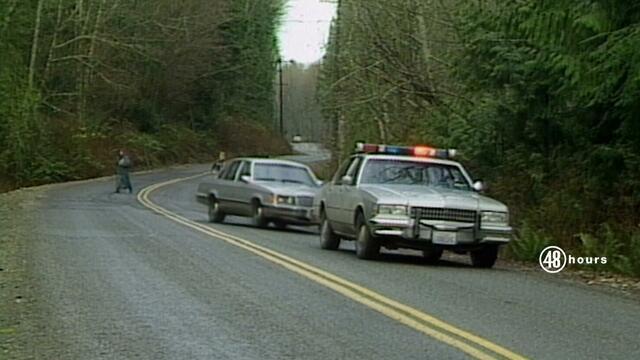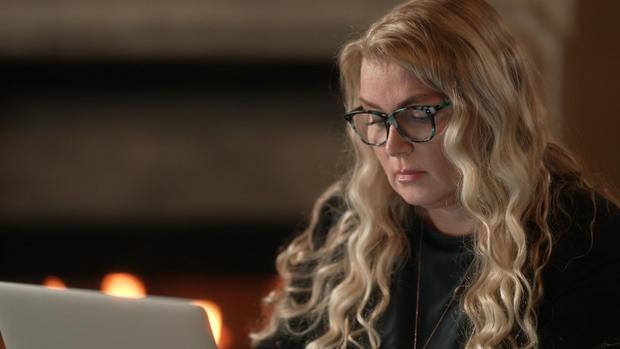▶ Watch Video: A Killer in the Family Tree
In 2013, Chelsea Rustad was 31 years old and realized she could not name a single one of her great-grandparents. As she told “48 Hours” correspondent Erin Moriarty, “It’s not that far back, right? But I couldn’t name them.”
So Rustad, a resident of Tumwater, Washington, went online to build her family tree. She learned her roots stretched from Washington State through North Dakota and back to Norway. She found new relatives and connected with them on social media. But it was a second cousin she never spoken to who turned out to be the one who would change her life forever. And it was a Halloween photo from when she was just 5 years old that set the whole process in motion.
“Whenever there’s a branch of the tree that I — or an individual that there’s very little info on … I’m kind of extra curious about that person, you know. Like … why is there nothing on them?” she said. When she started her search, Rustad had found a family of second cousins from Snohomish County — the Talbotts. Rustad was able to connect and exchange messages with the sisters, but their brother, William Earl Talbott II, was all but invisible.
“The most striking thing about him would be his absence. He doesn’t have a social media presence. No Facebook. No Instagram. No Twitter. No YouTube,” Rustad told Moriarty in “A Killer in the Family Tree.” “Usually, people have some type of internet presence … and there was nothing for him. I thought that was strange.”
Rustad continued her genealogy work, adding great-great grandparents and building out branches of her tree. In 2015 she entered an Ancestry DNA contest — submitting a photo of herself at 5 years old, dressed as a ballerina on Halloween. That photo must have been a lucky charm, because out of hundreds of entries, Rustad was one of two to receive a free home DNA test kit. She took the test, sometimes known as a “spit kit,” and her results confirmed the ancestry she’d already mapped in her family tree.
Then Rustad took a crucial next step, posting her raw DNA from the kit to a website called GEDmatch, where users can share their results in an open database. Rustad spent about an hour on GEDmatch that day in 2015 after uploading her data, but she didn’t find any new family members and didn’t think about it again until 2018 when police knocked on her front door.
In April 2018, the Golden State Killer was arrested in California after familial DNA was used to identify a suspect from crime scene DNA. When Snohomish County detective Jim Scharf heard that news, he wondered if the same process would work on a notorious cold case in Washington State he’d been trying to solve for many years — the 1987 murders of Tanya Van Cuylenborg, 18, and her boyfriend Jay Cook, 20. The couple had disappeared while running a long-distance errand to Seattle from their homes in British Columbia and had been found, in two separate and horrific crime scenes, in Washington State the following week.
Cook had been strangled, beaten to death and left near a river in Snohomish County, more than an hour north of Seattle. Van Cuylenborg was the victim of an apparent rape and had been shot in the head. Her body was found by the side of the road in Skagit County about an hour north of Cook’s. Cook’s van was found in a town near the Canadian border, parked near a bus station, and inside were Van Cuylenborg’s pants, stained with a stranger’s semen that matched semen recovered from her body.
After hearing of the Golden State Killer suspect’s arrest, Detective Scharf reached out to Parabon Nanolabs, a company that had been doing DNA work with his office. He was connected with their genealogy expert CeCe Moore. Moore had been unraveling family secrets for adoptees and others for many years and was a master at building family trees using consumer DNA —a practice called genetic genealogy that Moore had helped pioneer.
Within days, Parabon had uploaded the suspect DNA from Van Cuylenborg’s pants to GEDmatch to see if the unknown suspect might have a match from among the fewer than one million GEDmatch users. Moore waited anxiously for a list of matches — relatives who shared enough DNA with the suspect to be extended family members. Would she be able to find a name for this unknown suspect after all this time?
Moore told Moriarty, “We’re hoping for at least a second cousin or closer at the top of that list. We can work cases with much more distant matches but that’s really optimal. And we used to call that being struck by lightning.”
“Were you struck by lightning in this case?” Moriarty asked.
“Twice,” Moore answered. “We were struck by lightning twice.”
Those lightning strikes were two people who shared enough DNA with the unknown suspect to be second cousins. One of them was Chelsea Rustad. Now Moore had to build that family tree, but she was feeling good about her chances.
“How long did it take you?” Moriarty asked. “Not as long as I thought it would,” Moore said. “Two hours.”
And the suspect she had identified? It was Rustad’s mysterious second cousin from Snohomish County — a truck driver named William Earl Talbott II. Talbott was 24 when Cook and Van Cuylenborg were killed and had grown up 7 miles from where Jay’s body had been found.
When Scharf got the call that Moore had found a name to match the suspect’s DNA, he didn’t believe it. “I’m like, really? You’re not joking?” Scharf said. It had been nearly 31 years since the murders and Scharf himself had spent decades on the case. Moore had found Talbott’s name in just two hours.
“That’s the power of genetic genealogy,” Moore told Moriarty.
“But how sure were you?” Moriarty asked. “Very sure,” said Moore. She had been practicing genetic genealogy for many years and she knew her results were good because she had spent days double checking them before telling anyone else.
The name William Earl Talbott II meant nothing to Detective Scharf. Talbott had never been on a suspects list and Talbott had a scant criminal record. Could he really be the person who had committed these very violent crimes? But when Scharf learned that Talbott had grown up just 7 miles from where Jay Cook’s body was found, he said, “There’s eight billion people in the world and you have a DNA profile … to somebody geographically that’s in your backyard? This has got to be a good tip.”
To confirm that tip, Scharf would have to match the DNA from the crime scenes to Talbott. A team tailed Talbott, eventually retrieving a paper coffee cup that fell from his truck. When Scharf learned the DNA from the cup was a match, he says he got tears in his eyes. “I can’t believe it. It’s so emotional. And then I’m like, yeah! We got him!” Scharf said.
Scharf made an arrest, and soon after, police were at Chelsea Rustad’s front door looking for information about her distant cousin. Rustad told them what she knew about Talbott — which wasn’t much. Talbott pleaded not guilty after his arrest, claiming the semen found at the crime scenes was from consensual sex. He went to trial in 2019 and a jury found him guilty. Talbott was sentenced to two life terms in prison without parole. He is appealing the verdict.
CeCe Moore says she was happy to have helped Cook and Van Cuylenborg’s families who had been living with so much grief and so many unanswered questions for so long. But she was also happy that her first case with law enforcement had been so quick to resolve.
“I’d had these doubts all these years. I was concerned about making this decision, and I finally decided to go ahead,” Moore said. “And the research just fell into place, which is unusual. … I have never had another case where the pieces came together in only two hours. … And so it does sort of feel like it was a sign — if you believe in those things — that I made the right decision.”
In the three-and-a-half years since finding Talbott on GEDmatch, Moore says she’s gone on to locate nearly 200 unknown suspects and victims for law enforcement using genetic genealogy.
And in the end, Rustad did connect with family members she had never known of before — the families of Jay Cook and Tanya Van Cuylenborg. After Talbott’s conviction, Rustad attended the sentencing and got to meet Tanya and Jay’s families and express her support.
Rustad couldn’t help but notice she was the only relative of Talbott’s in the court that day. “His dad wasn’t there. His sisters weren’t there,” she said. “He had a family member in the audience, and I was there supporting the victims.”
That old Halloween photo that helped launch this journey has a whole different meaning to her now. By haunting coincidence, it was taken in 1987, just a few weeks before Cook and Van Cuylenborg were killed.
Rustad says she’s proud her DNA proved so useful and says to those who may feel nervous to unlock the secrets in their own DNA, “All it’s going to show you is the truth and nothing more.”






































